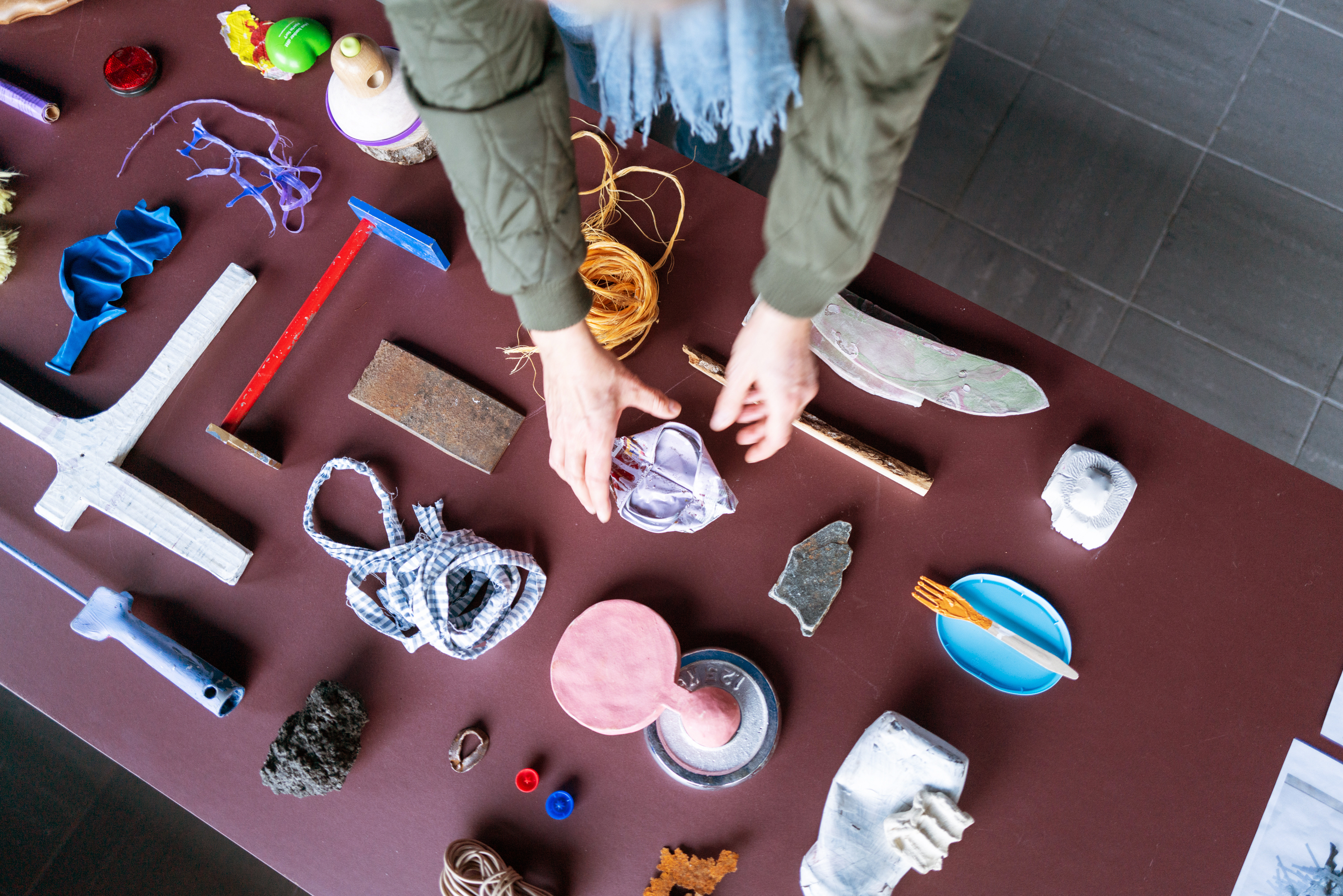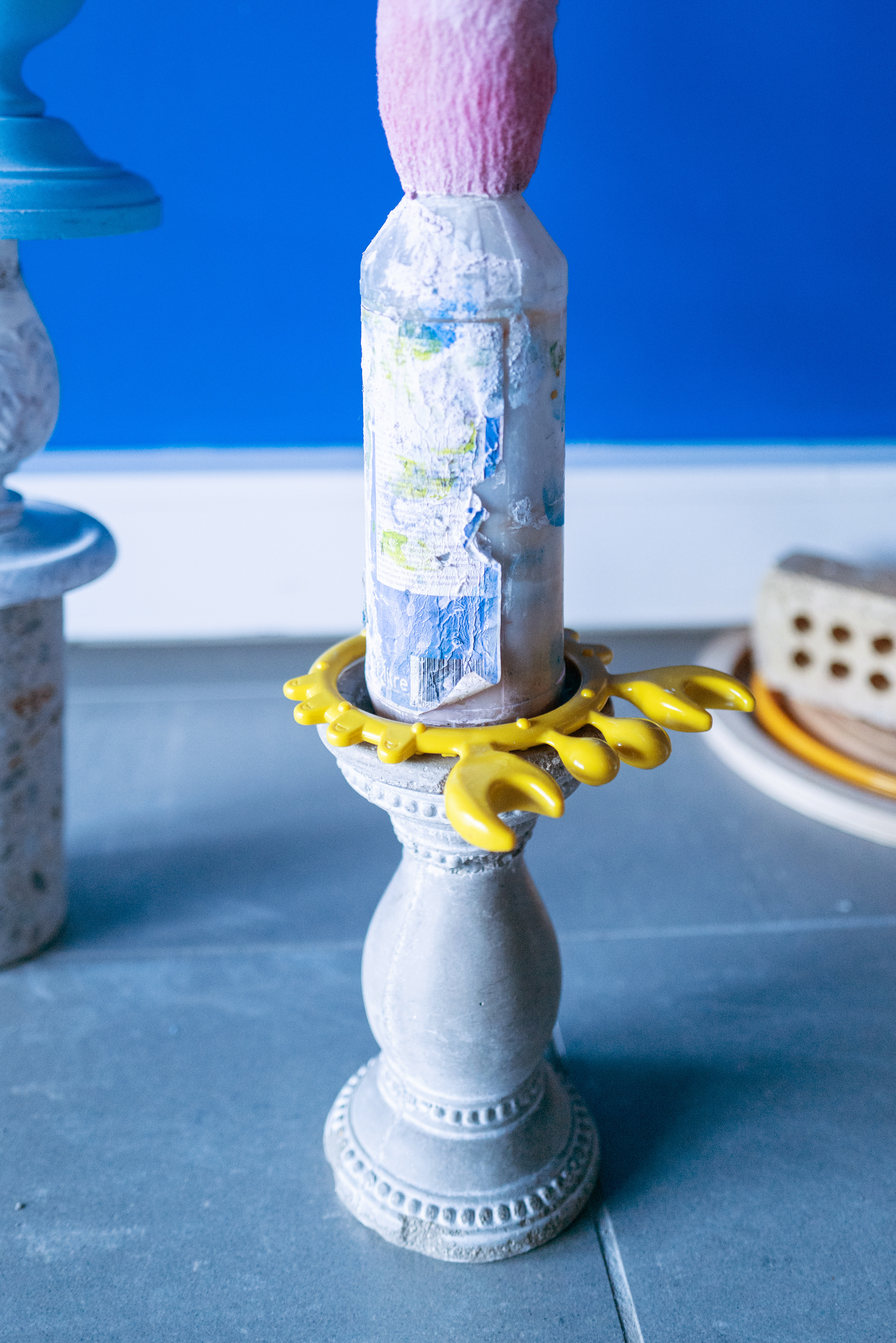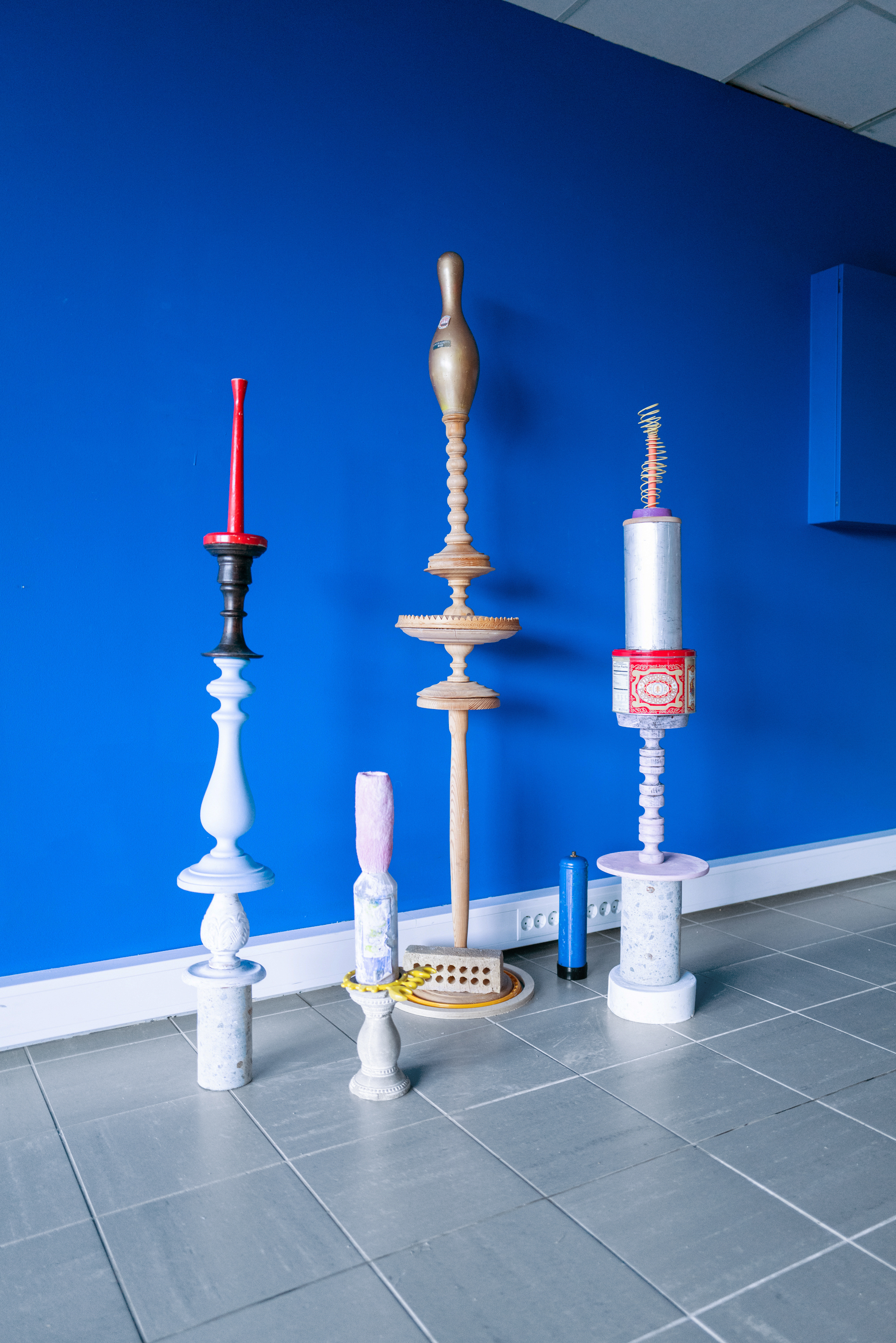Images by Johanne Karlsrud
METTE SANDFÆR
KIOSKEN STUDIO RESIDENT: OCTOBER
RESIDENCY & INTERVIEW
01.10.2023 - 31.10.2023
In October, we welcomed Mette Sandfær as our KIOSKEN STUDIO resident. Mette is a Danish artist who graduated from the MA Fine Arts at KMD in 2023. She works across multiple mediums, using and reúsing found objects to explore the changing interrelationality of objects, the spaces between them, and the space between us and them.
“Essentially, it is about finding new ways to look, to encounter and to think about these discarded materials, sometimes it is about turning the hierarchies upside down, but also simply about the meeting between the materials itself.”
During her residency at Kiosken, Mette Sandfær brought her intuitive practice of gathering and arranging to our blue walls. Working with found materials, she looks for their sculptural potential or hidden stories, finding new ways to use them and create relationships between them. In Kiosken, she worked in constant experimentation and fluctuation, as the objects moved around the windows and walls, finding new homes and friendships amongst each other.
I met her in her studio in January, as part of KIOSKEN IN CONVERSATION, where we talked about her work at Kiosken. You can read the interview below, alongside photos from her closing event - Collection Trap, which took place on November 2nd.
KIOSKEN STUDIO is a unique residency program that spans across the entire field of contemporary art, craft and design. During their residency, artists, designers, writers, musicians, performance artists and filmmakers are invited to work on ideas they want to further develop at Kiosken's premises for a period of four weeks. The public can follow the process through the large shop windows facing the street. KIOSKEN STUDIO is organised through an open call.
Kiosken is an interdisciplinary gallery and project space dedicated to artists, designers and artisans in the region. Through our shop, residency- and exhibition program, we aim to increase the visibility and earning potential of arts, crafts, and design in Vestland. KIOSKEN STUDIO is possible thanks to the generous support of Bergen Kommune, Vestland Fylkeskommune, Kulturrådet and KORO.



KIOSKEN IN CONVERSATION: METTE SANDFÆR
KIOSKEN IN CONVERSATION is a series of interviews that engages with our current exhibiting artists, KIOSKEN STUDIO residents and the Kiosken Shop community through conversations about their practices.
Mette and I met in her studio, just down the road from Kiosken, at C. Sundts Gate 55. It was an icy, bitter January afternoon. With strong black coffee steaming in our cups, we sat surrounded by her work - where recognisable household figures (an ironing board, crutches, a blue suitcase, a high-visability jacket) met with papier mache, rope, newspaper piles and rocks. The ironing board has an air-bag strapped to it - made from the used silver pouch from a box of wine. It leans against the wall next to a bright red fire extinguisher. Mette points out that the fire extinguisher was not one of her works, but it does look at home amongst her sculptures.
M: Mette Sandfær
R: Ruby Eleftheriotis
14.01pm Sunday 7th of January 2024
R:
Can you tell me a little about your time at Kiosken?
M:
I called my work at Kiosken Collection Trap. It included previously used materials and objects that were mounted in a grid of 3 orange bands, stretched to the wall. I tested 5 installations on the wall during the residency, starting very simple, and then leading up to the final installation, which was previously used materials mashed into a bag, so heavy it was barely possible for it to hang. The idea to hang my material up on the wall came from my fascination with trompe-l’oeil. I looked a lot at an artwork by a Dutch painter [Still-Life (1664) - Samuel Dirksz van Hoogstraten], where 3 ribbons hold different objects.
R:
Yes, I remember in that final installation you had objects on the wall - and then on the table, or like on a bench. I hadn’t seen you do something like that before.
M:
I’m very interested in examining different possibilities for exposing my stuff. The table was kind of new. We had this open studio at B-Open in September, and I had just moved into my studio, and I thought, how can I tell people that I’m very interested in materials? And so I made a table with these shapes, because I think it’s quite easy for people to relate to as they can recognise the shapes and see the spaces in-between. And it’s a limited area in a way, so it’s kind of easy to…
R:
To digest?
M:
Yeah, yeah. So I wanted to use that idea again.
R:
A lot of the artworks you make utilise found objects. And you re-imagine the ways they can be presented, by making unusual pairings, playing with form, and playing with the spaces between them. Can you talk a bit about your method of finding these objects and working with them?
M:
I work a lot with rules and limitations - I’ve always had rules. I like to work with objects that I’ve used before, and finding new ways to relate to them, and new ways they can relate to each other. What happens when two things meet together? Do they clash, or is it like a happy marriage?
I often think in silhouettes. Thinking about the overall shapes and spaces the objects can take up. I’m drawn to using things I find, walking around the streets, rather conjuring shapes and images out of your own mind. Obviously, it is my own mind that creates the objects ultimately, but I like to leave something to chance, to luck.
R:
It’s like you are creating your own language, but borrowing from a language of objects that aren’t yours originally.
Have you ever used more natural materials - like sticks, branches?
M:
Actually yeah. I had an exhibition at Bergen Kjøtt during my MA, where I used a lot of branches. Actually it’s my branches laying over there [points to a pile of branches leaning against a wall]. I do use branches, but not a lot. But it’s okay, I’m allowed to do that [laughs].
R:
But you disguise them quite a lot. And now I think about it, you use rocks a lot right?
M:
Yeah, they are very useful, because they are free and you can use them for stabilising. It’s a lot about trying to keep up, keep your work standing, so I use them as weight plates in a way.
R:
There’s often a mixture between really light materials and really heavy materials. And to me it plays with the idea of expectations... The contrast of materials makes me forget the intrinsic properties of the materials, they become new.
M:
I like that there’s humour. I think if there isn’t humour it is very hard to do anything in life. You have to laugh, because everything is absurd. You know? And I like the clash between - exactly - these practical materials… And the clash between something that you cannot figure out what it is, and then, for example this jacket [points to a sculpture with a hi-vis jacket wrapped around it], that kind of brings you back to everyday life, to what you know.
R:
Everyone knows that the jacket is a symbol of, of caution…
M:
I like that you switch from something you don’t understand at all, that is maybe absurd and ugly, then you get this piece of pizza tray and suddenly you think, “woah, I gotta eat pizza tonight” [laughs]. Your mind is kind of moved around in a way.
R:
You play with the langauge of signs and symbols. It brings me back to the trompe-l’oeil too, this idea of an illusion, of playing with expectations.

R:
Are there any references you keep coming back to in your practice?
M:
Robert Rauschenberg, when he wasn’t famous and he was poor, he did this walk around one block, where he collected stuff and if he didn’t find enough, he would walk the next block. And that was what he could use. It’s also a kind of limitation. And I love Rachel Harrison, because I love her humour. She pushes things… she changes them. You get an idea of what you are looking at, and then you suddenly discover one weird little thing and the whole picture changes. I like that very much.
R:
Like clues almost?
M:
Like clues… I’m not sure I understand all the clues though… [laughs]
R:
[laughing] Life would be boring if you understood all the clues!
M:
Yeah exactly, you don’t have to understand everything!
R:
The Rauschenberg walk around the block method, it reminds me of the Dada artists - particularly their writing exercises, where they had these rules. I can’t think of an example, but they would set themselves parameters to work within, and you start to see that within these parameters, spaces are created for coincidences to happen. When you first encounter these rules, perhaps it sounds too rational, controlled… limiting even, but by giving yourself a framework, you allow for surprises, for the unexpected within the expected.
M:
Exactly, that’s very much where I aim to be when I’m working. I also think a lot about the Arte Povera movement - a very simple way of working using very simple materials.
R:
And before we finish up, any new projects or ideas that have come from your time at Kiosken?
M:
I had a great time at Kiosken, trying out possibilities, working on the wall… it had been a very long time since I did that. On February 2nd, I will open at exhibition at Tag Team, showing new objects that are built from previous objects that I have dismantled, as well as new material I have found on my walks in Bergen.




